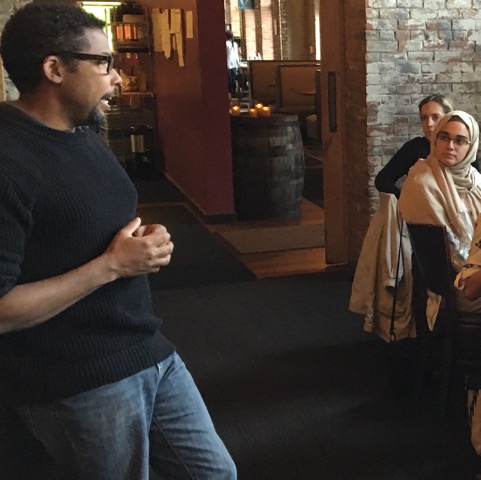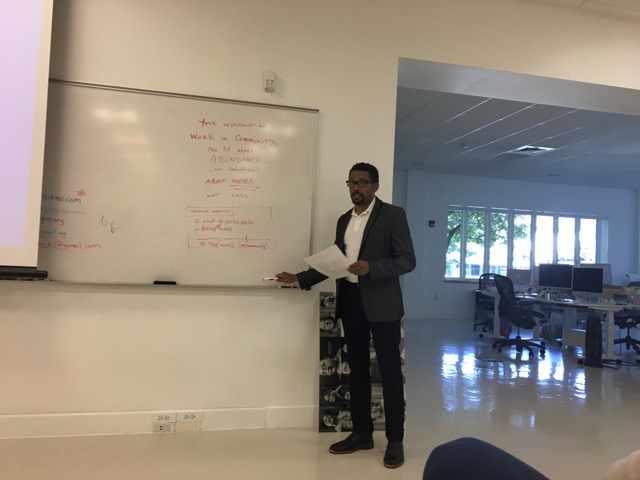From June 9 – June 12, Rich and Zoe led an equity workshop and three-day course titled Wonder and Crisis: Ethics at the Intersection of Creativity and Community for Nomad/9, the Interdisciplinary MFA program at the University of Hartford. We opened up the course to community members to come, sit in and participate in discussions through out the week.
About the Course
This course explored ethical frameworks and challenges that come with community engagement and social change, the roles we play in our own communities and as outsiders in new communities as both individuals and as artists, and design thinking principles. The course encouraged students to recognize the bias and personal narrative that we each have as lenses for viewing the world around us, to practice seeing the barriers to inclusion that exist within our own communities, and reflect on the role of design and art in perpetuating and dismantling these barriers.
Throughout the course, we will be met with several Hartford community leaders to get their perspectives of life in the City, and the various roles they play in affecting social change. Read about it below.
Course Recap
Day 1
We started off our time together with a workshop on social equity. In it we reviewed some key concepts, such as: systems design, power, privilege, marginalization and centeredness, bias, intersectionality, the difference between equality and equity, and the importance of understanding intention versus impact.
We then had a great dinner at Firebox restaurant, where we learned about the journey and changes to mission that Billings Forge Community Works undertook to better support their mission and those that they serve.

Pictured: Rich talking to Nomad/9 students and faculty about the growth and shifts in programming at Billings Forge.
Day 2
We started off this day by thinking about our roles in community as individuals and as artists. We began to think about the various roles we play in our own communities and the communities we enter into by watching a documentary on activist Grace Lee Boggs.
Rich then presented his own recent experience in doing a public art piece for a community he is not originally from in Virginia Beach. You can check out the work here.
Day 3
We started off this day by meeting with Hartford City Councilwoman Wildaliz Bermudez to talk to us about her experience with activism, her decision to run for city council, and her role in creating social change from “within the system”. We learned about both the challenges she’s faced and the success she’s had, as well as the importance of having allies in community advocating from outside the government institution.


Pictured: Councilwoman Bermudez presenting to the class at the Hartford Municipal Building.
We then met with filmmaker Pedro Bermudez to talk about his work, including his most recent short documentary, the documentary For Ahkeem, and the lenses we see through as individuals as well as those we place on other as artists, and the importance of how we frame a story.

Pictured: Pedro Bermudez presenting to the course in a classroom located in Hartford Public Library. Here he is asking students to talk about the end frame from the film For Ahkeem.
We then made our way to Veo Veo Design Studio to meet with Constanza Segovia, to talk about her recent work as both an artist and an activist.


Pictured: Constanza Segovia talking to students, artwork from her home/studio, and a slide from her presentation.
Finally, we headed back to Free Center to discuss design thinking principles. We were able to watch a presentation by Emily Norton, co-director at Smith College’s Design Thinking Initiative. Additionally, each student received Creative Reaction Lab’s Equity-Centered Community Design Field Guide. We discussed both the importance of design thinking principles of involving the community being served in the design and solution process, live prototyping, changing based on learning and the iterative process, as well as the limitations to the recent various guides that have emerged, as well as avoiding the idea of just “checking off a box” saying that a design thinking strategy was implemented. It is a constant process.
Day 4
We began this morning with our final guest lecturer, photographer and professor at Trinity College, Pablo Delano. He presented two of his projects: first, a photo series he has exhibited of Hartford, titled Hartford Seen. He then presented a growing installation he has, The Museum of the Old Colony.


Pictured: Pablo Delano presenting on his two projects, Hartford Seen (left) and Museum of the Old Colony (right)
The course ended with discussion synthesizing what we’d learned from the various presenters and topics over the last few days. We ended by having everyone contribute their ethical takeaways, guiding principles for moving forward in their own work. These takeaways included:
- Recognize your intentions (and that your impact may differ from your original intention)
- Know what’s missing and who’s missing from the conversation (and correct it!)
- Listen actively
- Pay attention to what your privileges are
- Pay attention to power dynamics
- Operate from consent
We came up with many more (30 to be exact)!


Pictured: Rich talking to the class in the Meeting Room at Free Center.
